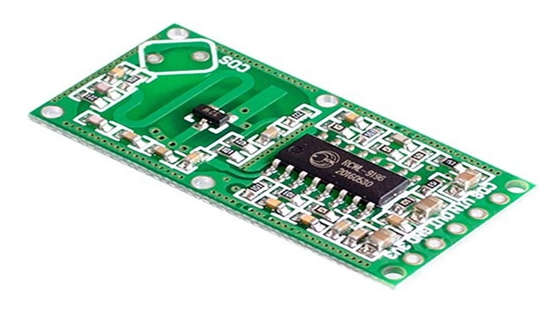What is an RCWL0516 Microwave Distance Sensor?
- The RCWL-0516 Microwave Radar Sensor module is a distance sensor and was created as a replacement for common PIR motion sensors.
- Distance sensors use high frequencies to determine the target’s distance. Microwaves are electromagnetic waves with VHF/UHF frequencies that are used for communication. Short microwaves are used in sensing applications, particularly radars, alarm systems, and human body detection.
- The RCWL0516 microwave distance sensor was designed to replace passive infrared motion sensors that use infrared light emitted by a moving person. To detect moving objects, RCWL0516 employs a doppler effect technique.

- This sensor, like the PIR sensor, detects only movements within its detection range. Instead of sniffing blackbody radiation from a moving person, this sensor detects moving objects using a microwave Doppler radar technique.
- The pin diagram of the RCWL0516 microwave distance sensor is shown below.
![]()
-
- CDS – Sensor disable input (low = disable).
- VCC – 4- to 28-V DC supply input.
- OUT – HIGH (3.3 V) motion detected/LOW (0 V) idle.
- GND – Ground/0 V.
- 3V3 – Regulated DC output (100 mA max).
Working of RCWL0516 Microwave Distance Sensor
- The microwave signals are captured and generated by the integrated antenna. When the antenna detects a reflected signal, it transmits it to the mixer/amplifier.
- The mixer/amplifier then combines the transmitted and reflected signals and sends the difference to the IC for processing. The IC will send an output voltage signal indicating the distance between the body and the sensor.
- It has a 7-meter sensitivity range. When triggered, its TTL-level output (OUT) pin changes from LOW (0 V) to HIGH (3.3 V) for a short period (2 to 3 s) before returning to its idle (LOW) state.
- This adaptable sensor module works well with a variety of microcontrollers and can even function without one. It can accept power supply inputs ranging from 4 to 28 V.
- The output pin can be used for a variety of tasks, such as driving an aural/visual indicator or connecting to the I/O of any 3-V microcontroller for additional processing. Avoid putting any metal parts in front of the sensor module during construction. Similarly, always leave a 1-cm gap on the front and back sides of the module.
Features and Specifications of RCWL0516 Microwave Distance Sensor
- RCWL-9196 transmission signal processing control chip.
- 4.0V to 28.0V operating voltage range.
- When compared to traditional infrared detection, the penetration detection capability is superior to PIR.
- Adjustable Time and distance are blocked.
- 3.3V power supply output.
- 4 to 28 volts direct current.
- Operating Current: 2.8mA (average); 3mA (max).
- 5-9m Detection Range.
- Power output: 20mW (typical); 30mW (max).
- 3.2 to 3.4 volts output voltage.
- 100mA Output Voltage Driving Capacity.
- Trigger Method Repeat Trigger.
- Low-Level 0V Output Control.
- 3.3V High-Level Output Control.
- Temperature range (C): -20 to 80.
- 36 mm in length.
- 17 mm in width.
- 2 mm in height.
- 3 gm in weight.
